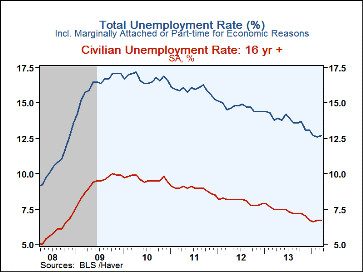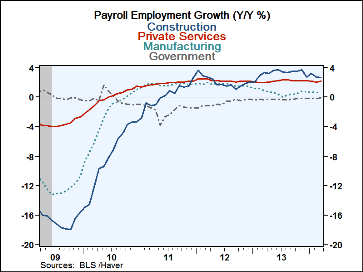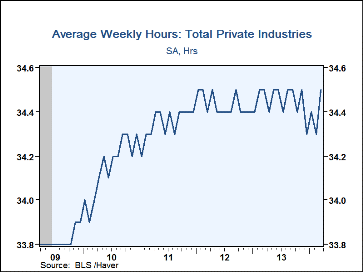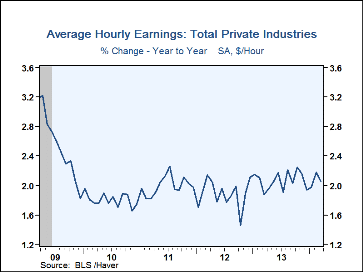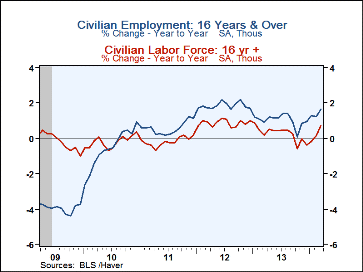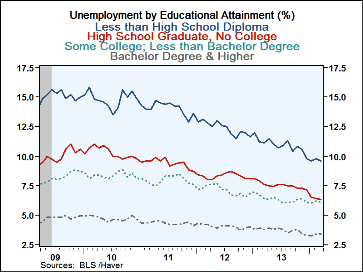 Global| Apr 04 2014
Global| Apr 04 2014U.S. Payroll Employment Gain is Steady and Firm; Jobless Rate Unchanged
by:Tom Moeller
|in:Economy in Brief
Summary
Nonfarm payrolls grew 192,000 during March following a 197,000 February increase, initially reported as 175,000. The rise roughly matched expectations for a 195,000 increase in the Action Economics Forecast Survey. The unemployment [...]
 Nonfarm payrolls grew 192,000 during March following a 197,000 February increase, initially reported as
175,000. The rise roughly matched expectations for a 195,000 increase in the Action Economics Forecast
Survey. The unemployment rate held at 6.7% versus expectations for a dip
to 6.6%. The total jobless rate, including workers who were marginally
attached plus part-time for economic reasons, ticked up to 12.7%. Average hourly earnings
were roughly unchanged (2.1% y/y).
Nonfarm payrolls grew 192,000 during March following a 197,000 February increase, initially reported as
175,000. The rise roughly matched expectations for a 195,000 increase in the Action Economics Forecast
Survey. The unemployment rate held at 6.7% versus expectations for a dip
to 6.6%. The total jobless rate, including workers who were marginally
attached plus part-time for economic reasons, ticked up to 12.7%. Average hourly earnings
were roughly unchanged (2.1% y/y).
From the payroll survey, the 192,000 increase in jobs followed two months of increase that were revised up a collective 37,000. The 19,000 m/m gain (2.6% y/y) in construction jobs lifted the three month rise to an average 29,000, the strongest in a year. Factory sector employment growth remained hesitant as payrolls fell 1,000 (+0.6% y/y). The three-month gain of 9,000 was its least in six months. In the private service sector, there was more life in job growth. The 167,000 increase (2.1% y/y) was its strongest since November. The three-month rise of 139,000 was, however, below the 202,000 peak nine months ago. A 57,000 increase (3.6% y/y) in professional & business services jobs led the jobs total higher. Within that grouping, temporary help services jobs grew 28,500 (9.6% y/y), the strongest rise in three months. Not far behind was a 34,000 increase (1.6% y/y) in education & health services employment. Hiring amongst leisure & hospitality establishments rose 29,000 (2.9% y/y). Retail trade jobs increased 21,300 (2.1% y/y) while wholesale sector employment grew 7,100 (2.1% y/y). Still in a slow-growth mode were information sector jobs, up 2,000 (-1.1% y/y), and financial activities hiring, up 1,000 (0.7% y/y). Government sector payrolls remained unchanged (-0.1% y/y); reflecting a 9,000 decline (-3.0% y/y) in federal government, a 2,000 drop (+0.2% y/y) in state government and an 11,000 rise (0.4% y/y) in local government payrolls.
The length of average workweek recovered to 34.5 hours following weather-depressed readings during the prior several months. The rebound in the goods producing sector was to a record 40.7 hours. The private service sector gain to 33.3 hours was to the highest level in four months.
The combination of stronger employment and longer hours-worked lifted aggregate hours-worked in the first quarter by 1.6% (AR) after a like gain during Q4.
The breadth of hiring eased a bit, again, last month. The diffusion index of 58.5% showed the lowest breadth of hiring increase in three months, and it was well below the 60.9% figure for all of last year. The factory sector figure of 50.0% was its lowest in nine months. The 2012 average was 54.2%.
The household employment survey indicated that the unemployment rate of 6.7% remained near its lowest level since the end of 2008. The stability resulted from a 476,000 rise 1.6% y/y in employment and a 503,000 gain (0.7% y/y) in the labor force. That increase reflected an improvement in the labor force participation rate to 63.2%, its highest level in six months. The employment-to-population ratio of 58.9% was the highest since mid-2009. The number of individuals not in the labor force fell for the fourth month in the last five. The number of workers out of work for 27 weeks or longer fell 18.3% y/y and the number out for 52 weeks or more declined 18.0% y/y. Of those unemployed, 24.8% were out 52 weeks or more.
By educational attainment, those without a high school diploma realized a 9.6% jobless rate while for high school graduates and no college it was 6.3%. Those with some college but no degree had a 6.1% unemployment rate while for college graduates it was 3.4%. By age, individuals over age 25 had a 5.4% jobless rate while those under 25 saw 14.5% unemployment. Teens were 20.9% out of work.
The figures referenced above are available in Haver's USECON database. Additional detail can be found in the LABOR and in the EMPL databases. The expectation figures are from Action Economics and are in the AS1REPNA database.
| Employment: (M/M Chg., 000s) | Mar | Feb | Jan | Y/Y | 2013 | 2012 | 2011 |
|---|---|---|---|---|---|---|---|
| Payroll Employment | 192 | 197 | 144 | 1.7% | 1.7% | 1.7% | 1.2% |
| Previous | -- | 175 | 139 | -- | -- | -- | -- |
| Manufacturing | -1 | 19 | 8 | 0.6 | 0.7 | 1.7 | 1.7 |
| Construction | 19 | 18 | 51 | 2.6 | 3.3 | 2.1 | 0.2 |
| Private Service Producing | 167 | 148 | 101 | 2.1 | 2.2 | 2.2 | 1.9 |
| Government | 0 | 9 | -22 | -0.1 | -0.3 | -0.8 | -1.8 |
| Average Weekly Hours - Private Sector | 34.5 | 34.3 | 34.4 | 34.5 (Mar'13) |
34.5 | 34.4 | 34.3 |
| Average Private Sector Hourly Earnings (%) | -0.0 | 0.4 | 0.2 | 2.1 | 2.1 | 1.9 | 2.0 |
| Unemployment Rate (%) | 6.7 | 6.7 | 6.6 | 7.5 (Mar'13) |
7.4 | 8.1 | 8.9 |
Tom Moeller
AuthorMore in Author Profile »Prior to joining Haver Analytics in 2000, Mr. Moeller worked as the Economist at Chancellor Capital Management from 1985 to 1999. There, he developed comprehensive economic forecasts and interpreted economic data for equity and fixed income portfolio managers. Also at Chancellor, Mr. Moeller worked as an equity analyst and was responsible for researching and rating companies in the economically sensitive automobile and housing industries for investment in Chancellor’s equity portfolio. Prior to joining Chancellor, Mr. Moeller was an Economist at Citibank from 1979 to 1984. He also analyzed pricing behavior in the metals industry for the Council on Wage and Price Stability in Washington, D.C. In 1999, Mr. Moeller received the award for most accurate forecast from the Forecasters' Club of New York. From 1990 to 1992 he was President of the New York Association for Business Economists. Mr. Moeller earned an M.B.A. in Finance from Fordham University, where he graduated in 1987. He holds a Bachelor of Arts in Economics from George Washington University.


